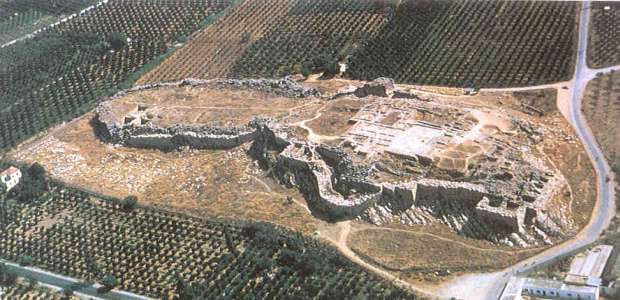Perched on a hilltop in the Peloponnese are the remains of a site said to be the oldest city in Greece and the fortress-citadel of Agamemnon, the warrior king of Homeric legend. One of the most sensational events in archaeological history occurred on 6th December 1876 when the german adventurer and amateur archaeologist Heinrich Schliemann uncovered the first of five treasure-filled shaft tombs in the site now known as Grave Circle A at Mycenae.
Excavation of the graves revealed 19 bodies, surrounded by gold jewellery, bronze weapons inlaid with gold and silver, gold breast plates, and gold and silver cups. Most splendid of all, in Shaft Grave V, Schliemann found a magnificent golden mask, which he was sure was the death mask of Agamemnon. According to the Greek epic poet Homer, writing in the eighth century BC, Agamemnon was the king of Achaea (which has been identified as Mycenae) and leader of the Greek forces against Troy. Schliemann at once telegraphed the Greek king the thrilling message: “I have gazed upon the face of Agamemnon”.

Schliemann’s excavations uncovered a vast quantity of rich and extraordinarily ornate treasures. His findings showed that the Mycenaean aristocracy was immensely wealthy which, along with the city’s advanced architecture, fuelled the widely held belief that the Mycenaean age was one of the exceptional achievement.
The city of Mycenae itself was at the heart of a great civilization that lasted for about 500 years from 1600 to 1100 BC and replaced the Minoan culture, based on Crete, as the dominant force in the Aegean and beyond. Pottery from Mycenae has been found as far afield as southern Italy, Cyprus, Egypt, Syria and Palestine, while hundreds of clay tablets, incised with a script known as Linear B, record the details of the rigid social hierarchy and complex economic system upon which the foundations of the city’s wealth were laid.
Schliemann’s assumption that he had located the burial site of Agamemnon was probably based on the writings of the second-century AD Greek geographer Pausanias, who had stated that Agamemnon was buried inside the city and that his murderers, Clytemnestra and Aegisthus, were interred outside the walls in beehive tombs. The shaft graves of Grave Circle A are indeed situated inside the walls of Mycenae, under the market place, but modern methods have dated them to around 1600 BC. This date has also been attributed to the ‘mask of Agamemnon’, which proved to be only one of several similar gold masks later unearthed, most of which are too stylized to have been death masks in the generally accepted sense. More importantly the Trojan War, if it happened in reality rather than in Homer’s imagination, occurred around 1200 BC, some 400 years after the bodies and treasures in the shaft graves at Mycenae were buried.
The citadel of Mycenae occupied a powerful strategic position, commanding the plain of Argos and controlling the mountain passes as ar north as Corinth. Its massive limestone walls, made of irregular blocks to a thickness of 16ft (5m), became known as Cyclopean, since later observers thought that only the mythical one-eyed giant Cyclops could have built them. At the main entrance to the city is the Lion Gate, constructed around 1260 BC. Here a pair of rampant stone lions are carved in relief above a lintel that measures 16ft (5m) long, 3ft (90cm) high and 8ft (2.4m) deep.
From the gate a road leads to the royal palace two blocks of buildings linked by corridors of storerooms. Inside, painted plaster floors and elaborate frescoes on the walls, similar to those found I Cretan palaces, show that the Mycenaeans must have had some knowledge of Minoan architecture. Around the palace are clustered he houses of lesser-ranking citizens, including one, the so called House of Columns, which was three storeys high.
Outside the citadel is Grave Circle B, a series of beehive tombs which are not as old as the shafts of Grave Circle A. These consist of up to 35 circular courses of huge stones, one on top of another, which became progressively smaller in the manner of an old-fashioned beehive. This type of grave was built over a period of about 200 years from 1400 to 1200 BC, usually into the side of a hill. A huge doorway at the end of a long passage gave entrance to the tomb; after each burial the doorway was walled up and the passage filled with soil. The most spectacular beehive tombs at Mycenae are the so-called Treasury of Atreus (Agamemnon’s father) and the Tomb of Clytemnestra. But although they date from the ‘right’ period, there is no real evidence that these are their graves. These tombs may have contained treasures to rival those of the shaft graves, but centuries of looting have taken their toll and all that remains of the Treasury of Atreus is the basic structure.

The Mycenaean civilization came to an end around 1150 BC when the city was either destroyed or abandoned: no one knows why. It was the last great early Greek culture and with its demise the country was plunged into the so-called Dark Ages: a period that only came to an end some 600 years later with the flowering of the Classical period.



































